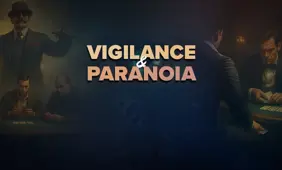The Ultimate Marked Deck Basics – Card Marking Systems

In recent articles, I’ve discussed the realities of using concealed devices against casinos or in private games, where there are perils and pitfalls that often outweigh the potential benefits of any such strategy. Yet even old scams are constantly being revised and re-invented to incorporate ingenious applications of modern technology.
In my home office, I am surrounded by a collection of books and artifacts that reflect my interests and fields of expertise. Most items in this room fall into three categories: film, magic, or scams.
I have many hundreds of books covering these topics; I own a few first-editions of rare texts, and when it comes to objects, my tastes can be quite diverse. For film, I own many cameras and lenses and tools for my job as a director and editor; for magic, I have a substantial collection of props ranging from dime-store tricks to professional hand-made miracles, and for my interest in crooked gambling, I own many items that were once used to rip off real people for real money.
Amongst this collection is a black box containing over fifty decks of playing cards - some still sealed - all with one thing in common - they’re all marked in different ways. Fifty different marking systems, among which is probably the best marked deck of cards, or at least I’d like to believe so. Fifty different ways to secretly identify cards. Maybe it sounds like a lot, but I’m well aware it’s a small collection, and there are many other card marking systems I could add to that box.
Creating the Ultimate Marked Deck
Marking systems tend to be designed or selected for specific game conditions where the way in which the marking system can be read might be specific to certain games or scenarios.
Do the cards need to be read from a short distance, from across the table, or from the next room? How will the cards be held or dealt, or placed when being read? Will the cheaters have access to the cards before the game, or can the deck be switched or marked during the game? What type of cards are being used? What is the back design? What is the plastic finish on the cards, and will it absorb or deflect the chemicals being used to create a mark?
These are just some of the questions cheaters need to ask themselves before operating with a marked deck, but there are many more factors to consider.
Over time, marking methods have become increasingly sophisticated, from the old days of using ink to adapt designs on a pre-printed deck to hitting cards with an invisible ink seen by hidden cameras that can detect marks invisible to the human eye.
Modern technology has opened the door to cutting-edge marking systems with hotel suites rigged with multiple, hidden IR cameras feeding a signal to someone nearby who transmits instructions to players at the table.
The most remarkable use of this technology offers cheaters an almost unbeatable edge that - when working properly - requires little to no skill and can be easily transported without drilling holes in a hotel wall.
Cheaters at the Table?
Imagine you have been invited to a private game in a hotel in Las Vegas where a dealer and full-size poker table have been provided. While playing, you find yourself losing to seemingly amazing calls from players who always seem to have your number.
For the most part, it might just seem like bad luck, but if you’re especially observant, you might begin to suspect that your opponents have an all too accurate read on your play.
There are several possibilities here:
- You are easy to read
- You are unwittingly exposing your cards
- The cards are being dealt by an expert mechanic
- The cards are marked
- You suck at poker
Of these, marked cards are the least likely reason depending on where you are playing, with whom, and for how much, but let’s imagine you’ve walked into a trap and hustlers are playing paint. And in this example, the cards have not been pre-printed for the purposes of bad magic or over-inked by clumsy cheaters; this is an expert version of a marked card scam using ink that’s completely invisible to the human eye but gives your hosts an incredible advantage.
Here’s what happens:
The dealer shuffles, sets the deck for a cut, collects bets then deals to each player. At this moment, the cheaters already know who is going to win and how to change the outcome. If the dealer follows the above procedure, they don’t even need to be in on the scam because the deck and a few items of modern technology are doing all the work.
How Exactly Do Card Marking Systems Work?
Hidden in the chip tray is a tiny wide-angle camera that can see deep into the IR spectrum and detect marks that have been pre-painted onto the deck. These marks are not on the back but on the edge of the deck, with each card having its own series of dots and dashes like a sort of ultra-thin barcode.
Stack fifty-two of these edge-marked cards together, and the side of the deck forms a unique pattern that, when scanned and processed, tells a hidden computer the exact order of the deck, and with a few simple calculations, a program can determine what hands will be dealt and who will win depending on the game played.
This information is then relayed to the cheaters, who can use that knowledge to adjust how they play. In fact, just having this knowledge should be enough to allow any team of hustlers to rake it in, but - believe it or not - not all cheaters are great players, and without some additional help, they might still lose if the cards don’t fall in their favor.
Some games like stud can allow a team of dealers to steer a winning hand (or block one) by folding or calling according to the computer’s instructions, but this is messy and requires concentration from all members of the team, so the best solution is typically to employ sleight of hand expert - a mechanic - to deal the cards and to follow instructions from the computer to change the outcome!
The advantage is that the deck can be legitimately shuffled and cut and then dealt with a couple of false deals to exchange cards between players or the board. There are more sophisticated ways to adjust the deal with the help of a mechanic, but the idea is the same: change the order of the cards to ensure the hustlers enjoy the best of it.
This may all sound like wishful thinking - a crooked gambler’s dream - yet it exists and can be purchased from several online sources, but as with all device scams, there are flaws and caveats and dangers to be overcome. In fact, many crooked games that have relied on this type of scam would have been a disaster if the mechanic wasn’t dealing and able to beat the game “the old-fashioned way.”
The system is powerful but also fallible and prone to glitches, so without a backup plan, a crew of cheaters might lose their shirt, and it begs the question: if you’re going to bring an expert mechanic to deal for you anyway, why bother with the James Bond bullshit?
Upgrading Card Marking
The chip tray was soon replaced by mobile phones with secret lenses drilled into their edge so they could read the edge of a deck from a player’s position across the table. I’ve seen new versions built into much smaller objects and devices that I’m not at liberty to reveal here.
There are other ways in which technology can be used by cheaters. Cards embedded with RFID chips are now used by online streaming games, TV games, and world championship tournaments, and there’s at least one example where a truly shitty cheater appeared to be intercepting the signal and playing in what some might call “God Mode.” His calls and bets were so insane that commentators on a live stream were freaking out while this guy kept looking at something in his lap before making those killer decisions.
Modern technology may one day render old-school playing cards obsolete in high roller casinos as electronic devices, and tiny computers open the door to more possibilities, and cheating continues to evolve in the twenty-first century, but in the end, these scams are just old wine in new bottles, and the old principles of cheating remain just as powerful today as they were fifty years ago.
Recently, I watched a friend play a game where the cards being used were protected by security guards before being opened at the table and used in the game, but after about twenty minutes of play, all the high cards were marked, and only an expert would be able to see the special ink being used, but once a player’s eyes had been trained, he or she could spot those marks from across the room.
This is a highly advanced car marking system used only by a handful of people who know the secret, but unlike the chip tray with a concealed IR camera, this method rarely fails and has been played by hustlers for over a hundred years.
Read more:





Review this Blog
Leave a Comment
User Comments
comments for The Ultimate Marked Deck Basics – Card Marking Systems